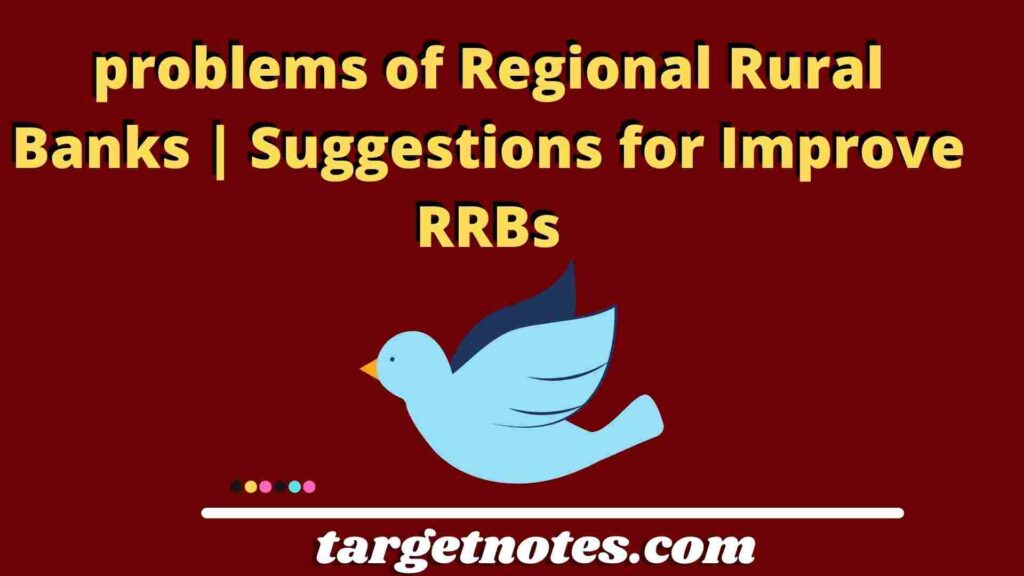
Contents
problems of Regional Rural Banks
(1) Lack of capital – In Regional Rural Banks there is a shortage of financial Resources. These banks are incapable in expanding the financial resources in accordance with the demand.
(2) Delay in repayment of debt – These banks grant loans to small and marginal farmers, small manufacturer and labours. Therefore loan amount does not repay in time.
(3) Granting Loans Without Sufficient Guarantee – Regional Rural Banks provide loan without sufficient guarantee. It delay in repayment of debts.
(4) In appropriate extention of branches – Regional Rural Banks, make in appropriate extention of his branches when functions of these banks are limited to a particular area.
(5) Faulty Coverage – The coverage varies from state to state. In some states backward areas have not been covered. In many districts these banks do not have link branches at the Taluka/Block Headquarters for meeting the cash requirements.
(6) Faulty Credit Policy – These banks have concentrated on giving only crop loans and for the schemes sponsored by the State Governments. Activities like cottage and rural industries have not been given due importance.
(7) High Loan Transaction Costs – Since the pay scales in the regional rural banks are the same in the commercial banks, their cost of loan transactions is very high and sometimes even higher than the rural branches of the commercial banks.
(8) Problems Related to Organisation – Proper systems and procedures within the institution of RRBs are also locking. No proper attention has been paid towards the recruitment and training of RRBs staff. The area restriction has also brought a constraint in its way.
(9) Rigidity of Norms – The norms prescribed for the selection of beneficiaries in these banks are very rigid and based on all India income level It is well known fact that economic conditions differ from state to state.
Suggestions for Improve RRBs
The problems faced by the RRBs are quite genuine. However, all these problems have to be solved, thus the following suggestions can be given in this connection:
1. Ownership and Control – Instead of these banks working as extensions of sponsor banks, they must be made to work independently as a separate entity. Formal regulatory measures can be chalked out at the apex body level, whereas the functional policies may be framed at the state level in the conjuction with state policies, priorities, needs and peculiar conditions.
2. Higher Capital – The RRBs must raise their capital to cope with the additional volume of business to deal with at least 50 percent of the population. Around 1 lakh branches will have to be opened, though in simpler scale, in order to cover the vast rural population.
3. Staffing and Training – The appointment and training of the staff working in these rural oriented institutions should be given much attention.
4. Targets and Motive – Profits should not be the only motive of these banks functioning for the welfare of the poor and the marginalised. They must function on service motto.
5. Area Covered and Branch Expansion – It is essential that all the villages, panchayats, blocks and talukas must come under these banks. India has about 5 lakh villages.
6. Management of Funds – Strict guidelines are to be issued as regards the deployment of funds, the wide areas of operation and the kind of debt to be serviced. It is rural sector reforms that should be borne in mind.
7. Development of Agro based Industries – Setting up of agro based units will be beneficial to the banks as well as the economic well being of the locality. The banks can expand their avenues of operation with the industrialisation of the rural sector.
Related Link
- Describe the various types of money
- Dynamic Functions of Money
- Evils or Demerits of Money
- Importance and significance of money in Modern Economy
- Approaches regarding Definitions of Money and its Function
- Money: Meaning, Definitions and features of Money
IMPORTANT LINK
- What is the Exchange Rate System in India?
- Evolution of foreign exchange market in India
- Meaning and importance of export finance.
- Role of Export-Import Bank in Financing India’s Foreign Trade
- How Commercial banks Export Finance to Overseas Importers?
- Explain packing credit in detail?
- What is Post-shipment credit?
- What is Pre-shipment or packing credit?
- Explain Export Credit in India?
- Institutions Providing Finance and Credit Facility for Foreign Trade
- What is Risk Analysis?
- Explain Political risks in detail? and its Types
- What are the types of Risks. Explain in detail?
- Meaning and Types of commercial risks
- How can we minimize foreign trade risks?
- What are Arbitrage operations?
- Difference between Spot Market and Forward Market
- What is spot exchange?
- Agency agreement: Meaning, Features and Advantages
- Functions of Foreign Exchange markets
- structure of Foreign exchange markets
Disclaimer






